SSDI vs SSI: Key Differences and Choosing the Right Benefit for You
Disability benefits can be confusing, especially since programs often overlap but serve different purposes. This landing page provides quick guides, tools, and resources to help you understand the most common programs, compare them side by side, and make better decisions about your eligibility.

What is the Disability Benefits Comparison Guide?
This guide is a hub for understanding the differences between the most common disability-related programs, including:
Social Security Disability Insurance (SSDI)
Supplemental Security Income (SSI)
VA Disability Compensation
Workers’ Compensation
Disability vs. Retirement Benefits
Each section explains who qualifies, how benefits are funded, and each program's unique features. Unlike focusing on just one benefit, this comparison helps you see the bigger picture and understand how programs may work together.
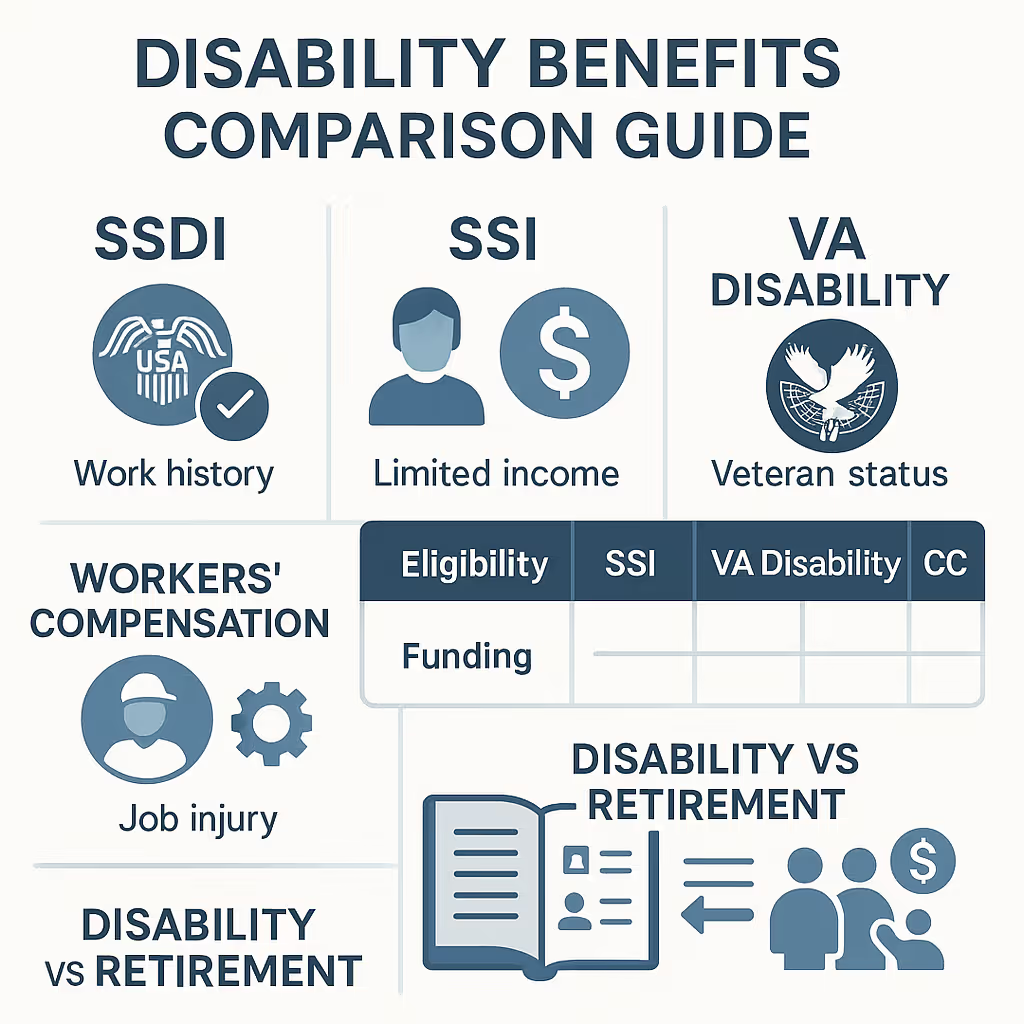
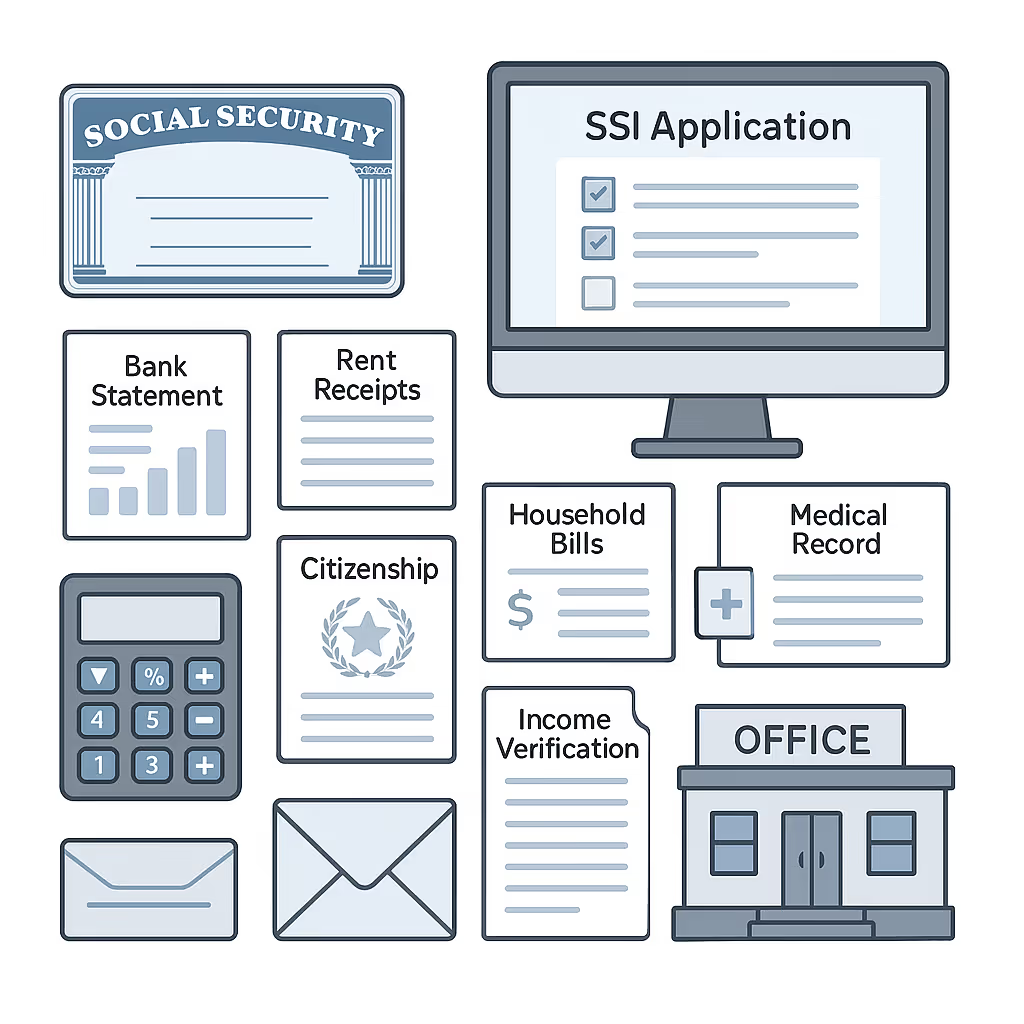
How to Use This Guide
The comparison process is simple. Each section of the guide provides clear breakdowns of eligibility, funding, and benefits. You can:
Compare Programs Online – side-by-side program breakdowns are available in this guide.
Speak by Phone – connect with a Social Security or VA representative for case-specific questions.
Visit Local Offices – Social Security, VA, or state workers’ comp offices can provide tailored support.
Tip: Start early. The sooner you know which programs apply to you, the sooner you can receive benefits.
Eligibility Rules
Eligibility requirements vary widely depending on the program:
SSDI – requires work history and enough credits from payroll taxes
SSI – needs-based with strict income/resource limits
VA Disability – for veterans with service-connected conditions
Workers’ Compensation – for employees with work-related injuries or illnesses
Retirement Benefits – based on age (62+) and work credits, not medical review
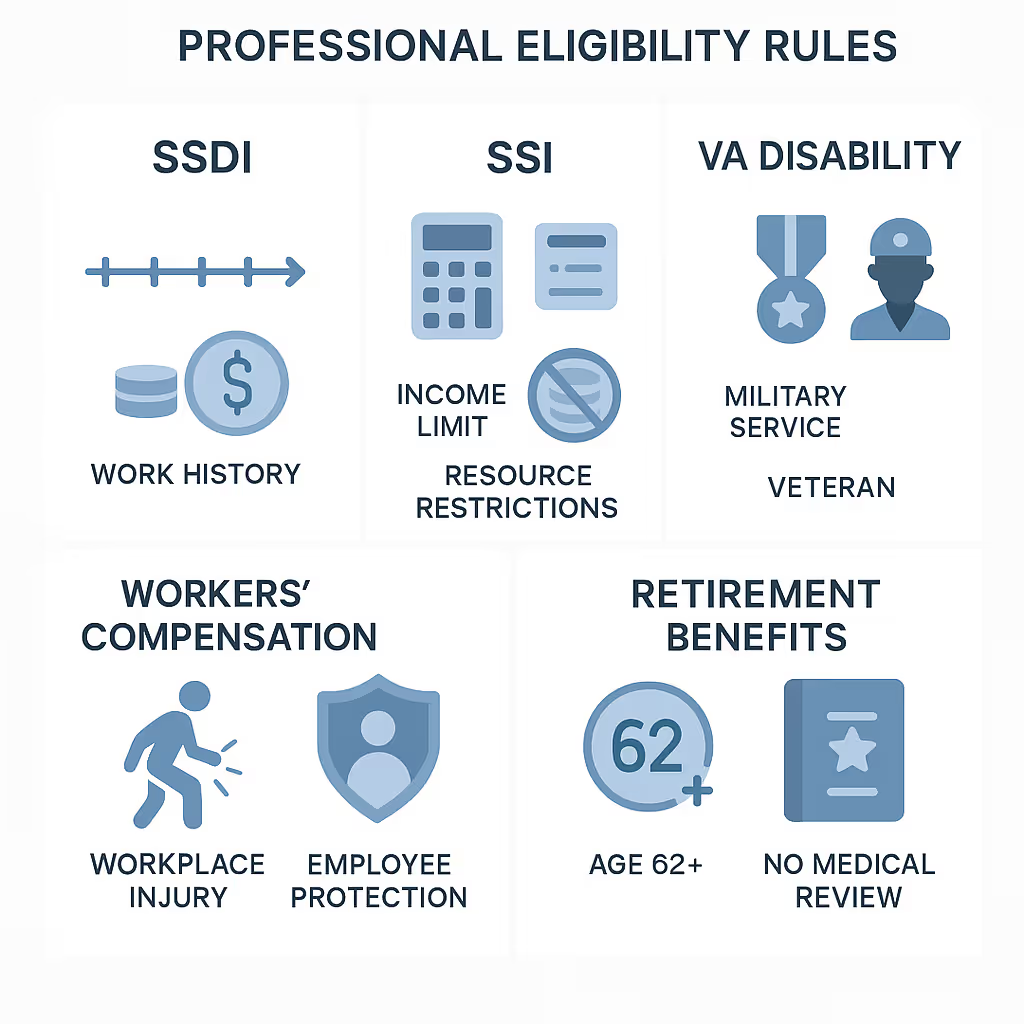
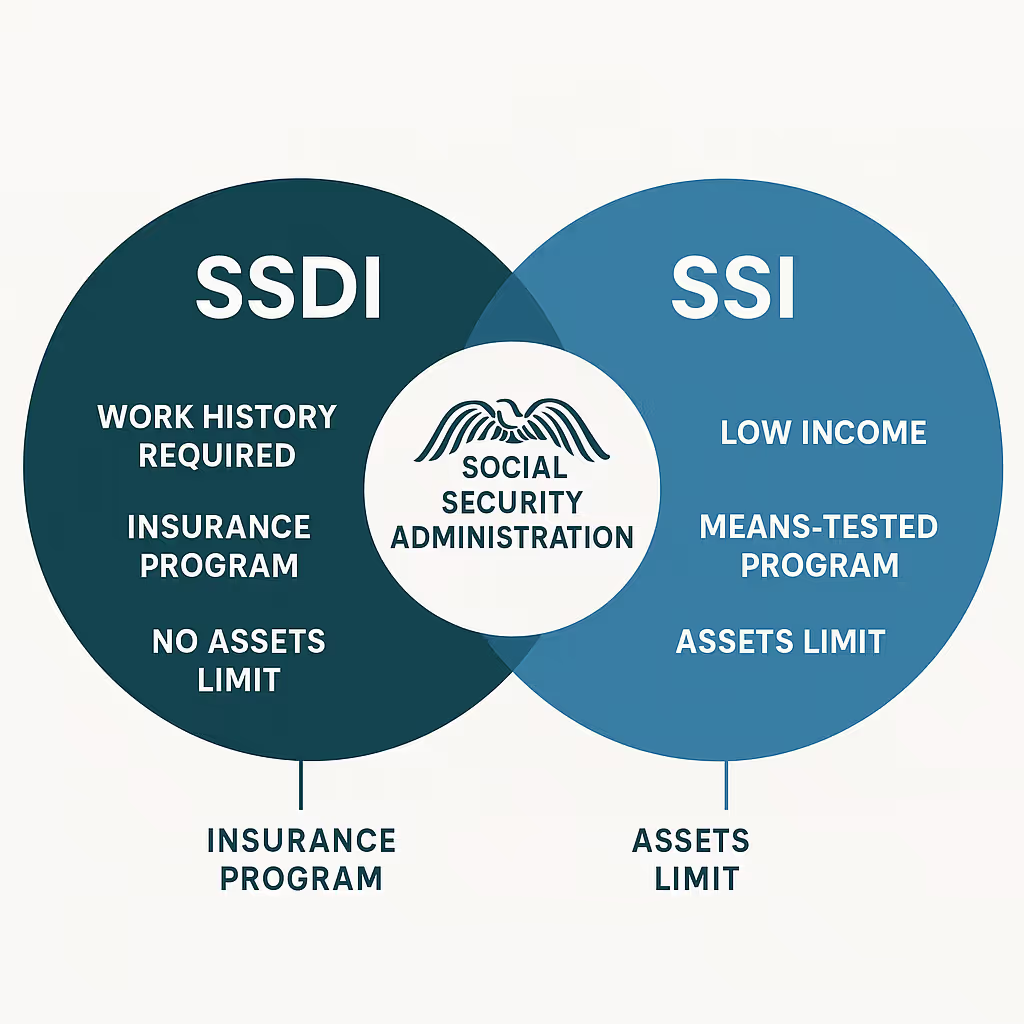
SSDI vs. SSI
These two programs are often confused, but here’s how they differ:
SSDI – Based on your work history and contributions to Social Security. Provides Medicare after approval.
SSI – Based on financial need, regardless of work history. Provides Medicaid in most states.
Funding sources:
Payroll taxes fund SSDI.
General tax revenues fund SSI.
Benefits for Children and Families
Some programs also extend coverage to children or dependents:
SSI for Children – available if the child has a disability and parents meet financial limits.
SSDI for Dependents – children or spouses may qualify for benefits when a worker receives SSDI.
Workers’ Compensation – may include family support if the worker is injured or deceased.
VA Disability – offers dependent benefits for veterans’ families.

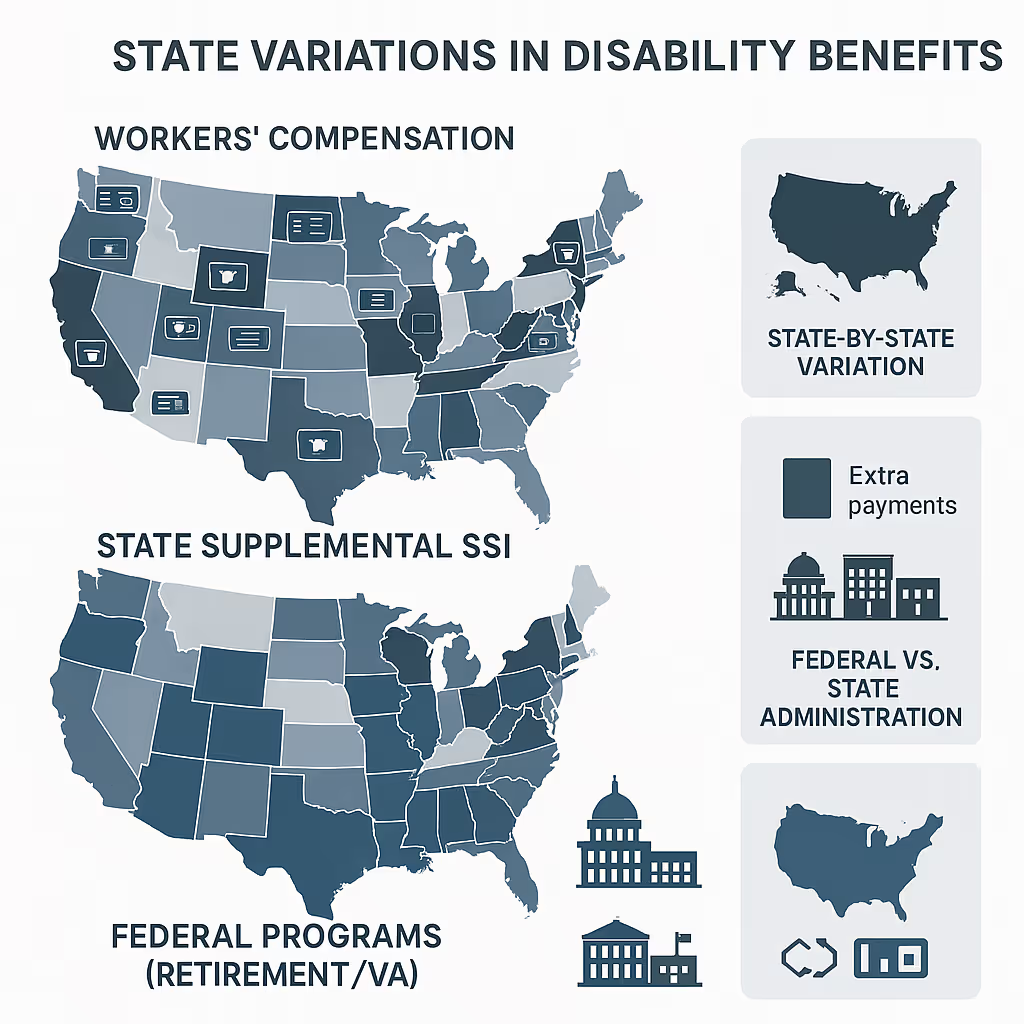
State Variations
Not all programs are handled the same way across states:
Workers’ Compensation – varies by state insurance systems and laws.
State Supplemental SSI Payments – some states add extra support for SSI recipients.
Retirement and VA Disability – federally administered, with consistent benefits across states.
Always check with your local office to confirm the exact benefits and rules for where you live.
Program Timeline Calculator
Timelines for benefits differ:
SSDI & SSI – often take 6–8 months for an initial decision.
VA Disability – may take months or years, depending on the backlog.
Workers’ Compensation – usually processed more quickly since it’s tied to employment.
Retirement Benefits – can often be started online with minimal delay.
Use our calculator to estimate your application's length, depending on the program.


Application Checklist
Before applying for disability benefits, gather these documents:
Identity Proof – Social Security card, birth certificate, military records if applicable
Financial Records – bank accounts, property deeds, insurance, tax returns
Medical Documentation – doctor’s reports, hospital files, prescription lists
Work History – jobs held, earnings, duties, and employment dates
Program-Specific Proof – military service documents (VA), employer forms (Workers’ Comp)
Frequently Asked Questions
The difference between Social Security Disability Insurance (SSDI) and Supplemental Security Income (SSI) comes down to eligibility. SSDI benefits require work history and paid Social Security taxes, while SSI benefits focus on limited income and resources. Both disability programs provide monthly benefits, but SSDI usually connects with Medicare, while SSI links to Medicaid support.
Some people qualify for SSI and SSDI benefits, which are called concurrent benefits. The Social Security Administration (SSA) reviews income, resources, and disability requirements to determine eligibility. For example, SSI can add support if your SSDI benefit amount is low. Comparing programs helps you make the best decision for your life and family.
When you reach full retirement age, SSDI benefits convert automatically to Social Security retirement benefits. Monthly benefits typically remain the same, protecting full benefits without reduction. SSI benefits don’t change at retirement. However, early retirement benefits claimed before full retirement can permanently reduce payments. The Social Security Administration confirms eligibility by birth year and work history.
Don't lose hope if your SSDI application or SSI claim is denied. Many disability benefits are rejected at first, but appealing can make sense. The Social Security Administration allows reconsideration and hearings to review qualifications, medical condition, income, and resources. Strengthening your claim with supporting documents increases your chances of being approved for crucial support programs.
Take the Next Step
Don’t let delays or paperwork stand in your way. Connect with a disability specialist today and get
clear answers about your eligibility for SSDI, SSI, or VA programs.
